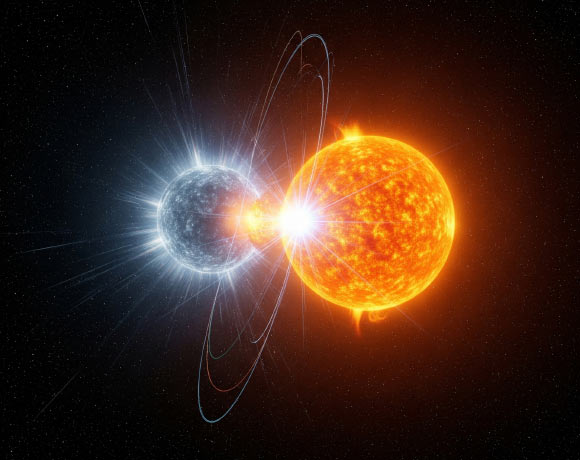This binary system contains a rapidly spinning millisecond pulsar called PSR J1928+1815 and its helium star companion.
Millisecond pulsars are rapidly spinning neutron stars that emit radio waves.
These stars achieve their extraordinary rotation rates by siphoning matter from a close stellar companion.
The formation of such exotic binary systems is not fully understood, because it can involve a variety of complex processes.
Theory predicts that binary systems can experience a common envelope phase, in which one stellar object orbits within the outer layers of its companion.
If the companion object in this evolutionary scenario is a neutron star, theory predicts that the outer layers are rapidly ejected, leaving a binary system composed of a recycled pulsar and a stripped helium star.
In a new study, Dr. ZongLin Yang, an astronomer with the National Astronomical Observatories at the Chinese Academy of Sciences and the University of Chinese Academy of Sciences, and colleagues characterized the millisecond pulsar PSR J1928+1815.
Using data from the Five-hundred-meter Aperture Spherical radio Telescope (FAST), they found that the pulsar has a spin period of 10.55 ms and resides in a tight binary system with a companion helium star, on a short orbital period of 3.6 hours.
They used stellar models to show that this system formed after an unstable transfer of mass from the companion star to the neutron star triggered the formation of a common envelope around both stars.
The neutron star spiraled closer to the other star’s core, releasing energy that ejected the outer envelope and left behind a tightly bound binary system.
“The companion star has 1.0 to 1.6 solar masses, eclipses the pulsar for about 17% of the orbit, and is undetected at other wavelengths, so it is most likely a stripped helium star,” the authors said.
“We interpret this system as having recently undergone a common envelope phase, producing a compact binary.”
“Although such systems are rare, we predict that others do exist,” they added.
“We estimate there are 16 to 84 undiscovered examples in the Milky Way.”
The discovery is reported in a paper in the journal Science.
_____
Z.L. Yang et al. 2025. A pulsar-helium star compact binary system formed by common envelope evolution. Science 388 (6749): 859-863; doi: 10.1126/science.ado0769

























